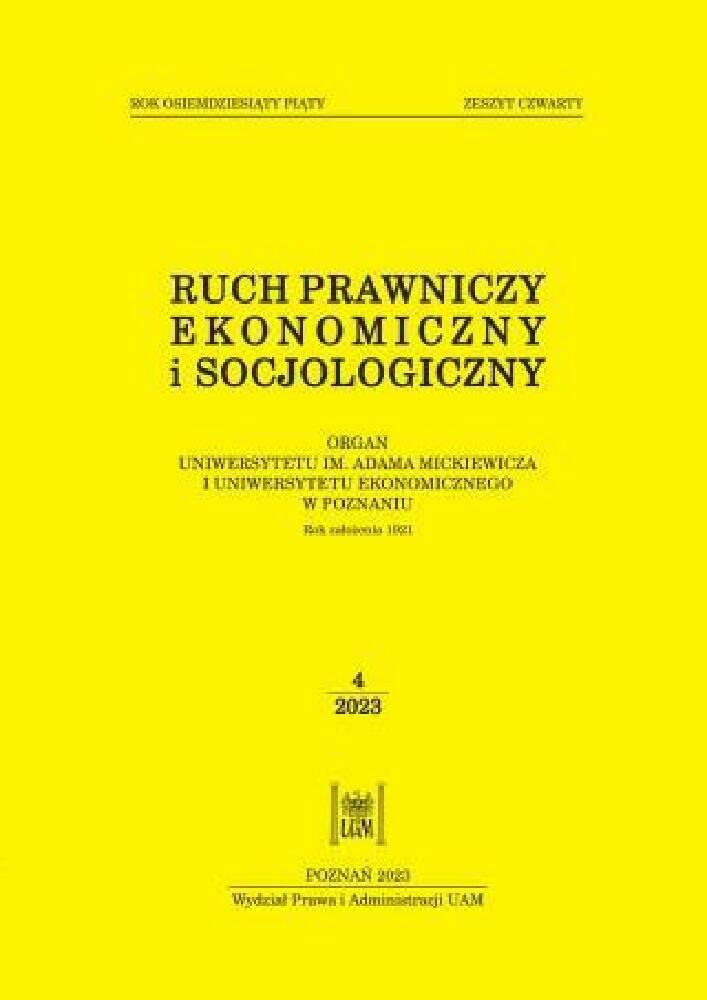Abstract
The article raises the problem of the incidence of so-called zombie companies in the economy. Zombie companies are most often defined as unprofitable, indebted, financially troubled companies that often have negative equity. The purpose of this article is to present the financial condition of zombie companies listed on the Warsaw Stock Exchange stock market, as well as to show the indications that threaten the continuation of business operations of zombie companies. The data from 2018–2021 is taken from the Notoria Serwis database, which refers to the annual financial statements of companies listed on the Warsaw Stock Exchange. The article uses literature analysis and financial analysis as the main research methods. The research results show that there are zombie companies with negative equity in the capital market in Poland, whose share among listed companies on the WSE stock market was 2.9–3.6% in 2018–2021. The most numerous group of zombie companies with negative equity were business entities included in the category of small businesses. Zombie companies listed on the capital market in Poland were mainly characterized by problems with ensuring profitability and maintaining liquidity, and their activities were accompanied by a high risk of bankruptcy. The zombie companies were able to continue their operations mainly due to the financial surplus they generated, which allowed them to pay principal installments plus interest. The continuation of zombie companies was mainly influenced by the continued low interest rates set by the monetary authorities in Poland 2018–2021, the government guarantees provided to businesses applying for bank loans, the subsidization of unprofitable operations, and the state aid directed to companies operating under COVID-19.
References
Adalet McGowan, M., Andrews, D., Millot, V. (2017). The walking dead? Zombie firms and productivity performance in OECD countries. OECD Economics Department Working Papers, no. 1372: 1-45.
Ahearne, A.G., Shinada, N. (2005). Zombie firms and economic stagnation in Japan. International Economics and Policy 2(4): 363-381. DOI: https://doi.org/10.1007/s10368-005-0041-1
Andrews, D., Petroulakis, F. (2019). Breaking the shackles: zombie firms, weak banks and depressed restructuring in Europe. Working Paper Series no. 2240: 1-56. https://www.ecb.europa.eu//pub/pdf/scpwps/ecb.wp2240~61e2d9dfec.en.pdf
Banerjee, R., Hofmann, B. (2018). The rise of zombie firms: causes and consequences. BIS Quarterly Review: 67-78. http://www.bis.org/publ/qtrpdf/r_qt1809g.pdf
Bereżnicka, J. (2017). Ujemny kapitał własny w przedsiębiorstwie a kontynuacja działalności. Annales Uuniversitatis Mariae Curie-Skłodowska Lublin – Polonia vol. LI, 4, Sectio H: 17-24. DOI: https://doi.org/10.17951/h.2017.51.4.17
Brown, P., Lajbcygier, B., Li, S. (2008). Going negative: what to do with negative boo equity stocks. The Journal of Portfolio Management 35(1): 95-102. DOI: https://doi.org/10.3905/JPM.2008.35.1.95
Caballero, R.J., Hoshi, T., Kashyap, A.K. (2008). Zombie lending and depressed restructuring in Japan. American Economic Review 98(5): 1943-1977. DOI: https://doi.org/10.1257/aer.98.5.1943
Fairchild, T. (2018). Negative Equity, Veiled Value, and the Erosion of Price-to-Book, By OSAM Research Team: 1-12. https://www.osam.com/Commentary/negative-equity-veiled-value-and-theerosion-of-price-to-book
Frick, W. (2022). Can zombie firms survive rising interest rates? They feast on cheap credit, which is drying up. Harvard Business Review Digital Articles: 1-6.
Gabrusewicz W. (2014). Analiza finansowa przedsiębiorstwa. Teoria i zastosowanie. Warszawa: Wydawnictwo PWE.
Góra, D. (2019). Zjawisko firm zombie i jego przyczyny. Ekonomia — Wroclaw Economic Review 25/3. Acta Universitatis Wratislaviensis No 3942: 9-23. DOI: https://doi.org/10.19195/2084-4093.25.3.1
Hamrol, M., Czajka, B., Piechocki, M. (2004). Upadłość przedsiębiorstwa – model analizy dyskryminacyjnej. Przegląd Organizacji 6: 35-39. DOI: https://doi.org/10.33141/po.2004.06.09
Jan, C.L., Ou, J.A. (2012). Negative-book-value firms and their valuation. Accounting Horizons 26(1): 91-110. DOI: https://doi.org/10.2308/acch-50094
Kawalec, S., Błażuk, K. (2021). Banki i inwestycje – zagrożenia dla dalszego rozwoju polskiej gospodarki. Raport Forum Obywatelskiego Rozwoju, Capital Strategy: 1-51. https://www.capitalstrategy.pl/wp-content/uploads/2021/02/Capital_Strategy-Raport-2021-Final.pdf
Kreczmańska-Gigol, K. (2010). Aktywne zarządzanie płynnością finansową przedsiębiorstwa. Warszawa: Wydawnictwo Difin.
Kuciński, A. (2018). Wypłacalność przedsiębiorstwa z punktu widzenia płynności finansowej i zadłużenia. Przedsiębiorczość i Zarządzanie 19(4.1): 119-131.
Machek, O. (2018). Determinants of becoming a zombie firm: a pitch. Journal of Accounting and Management Information Systems 17(4): 677-684. DOI: https://doi.org/10.24818/jamis.2018.04009
Mączyńska, E., Zawadzki, M. (2006). Dyskryminacyjne modele predykcji bankructwa przedsiębiorstw. Ekonomista 2: 205-235.
Mokhova, N., Zinecker, M. (2016). Corporate negative equity: the evidence from the European Union. Acta Universitatis Agriculturae et Silviculturae Mendelianae Brunensis 64(3): 1021-1036. DOI: https://doi.org/10.11118/actaun201664031021
Nehrebecki, M. (2023). Zombification in Poland in particular during COVID-19 pandemic and low interest rates. Bank i Kredyt 54(2): 153-190.
Nowak, E. (2017). Analiza sprawozdań finansowych. Warszawa: Wydawnictwo PWE.
Peek, J., Rosengren, E.S. (2005). Unnatural selection: perverse incentives and the misallocation of credit in Japan. The American Economic Review 95(4): 1144-1166. DOI: https://doi.org/10.1257/0002828054825691
Schivardi, F., Sette, E., Tabellini, G. (2017). Credit misallocation during the European financial crisis. BIS Working Paper no 669: 1-65. DOI: https://doi.org/10.2139/ssrn.2954537
Shen, G., Chen, B. (2017). Zombie firms and over-capacity in Chinese manufacturing. China Economic Review 44: 327-342. DOI: https://doi.org/10.1016/j.chieco.2017.05.008
Sierpińska, M., Jachna, T. (2004). Ocena przedsiębiorstwa według standardów światowych. Warszawa: Wydawnictwo PWN.
Storz, M., Koetter, M., Setzer, R., Westphal, A. (2017): Do we want these two to tango? On zombie firms and stressed banks in Europe. ECB Working Papers, no 2104: 1-48. DOI: https://doi.org/10.2139/ssrn.3052072
Urionabarrenetxea, S., San-Jose, L., Retolaza, J.L. (2016). Negative equity companies in Europe: theory and evidence. Business: Theory and Practice 17(4): 307-316. DOI: https://doi.org/10.3846/btp.17.11125
Urionabarrenetxea, S., Garcia-Merino, J.D., San-Jose, L., Retolaza, J.L. (2017). Living with zombie companies: do we know where the threat lies? European Management Journal 36(3): 408-420. DOI: https://doi.org/10.1016/j.emj.2017.05.005
Wędzki, D. (2015). Analiza wskaźnikowa sprawozdania finansowego według polskiego prawa bilansowego. Warszawa: Wolters Kluwer.
Workman, Z.A. (2021). Profitable restaurants reporting negative equity: causes and implications for investors. Financial Accounting eJournal: 1-37. DOI: https://doi.org/10.2139/ssrn.3825098
License
Copyright (c) 2023 WPiA UAM

This work is licensed under a Creative Commons Attribution 4.0 International License.





